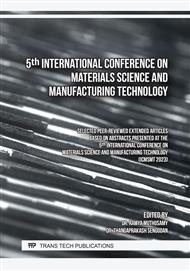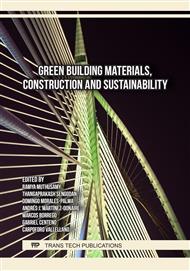[1]
Hooton R, Khaloo A. Crushed Tile Coarse Aggregate Concrete. Cement, Concrete and Aggregates [Internet]. ASTM International; 1995;17(2):119. Available from:
DOI: 10.1520/cca10137j
Google Scholar
[2]
Raval AD, Patel IN, Pitroda J. Re-use of ceramic industry wastes for the elaboration of eco-efficient concrete. Int. J. Adv. Eng. Res. Stud. 2013;2(3):103-5.
Google Scholar
[3]
González-Fonteboa B, Martínez-Abella F, Herrador MF, Seara-Paz S. Structural recycled concrete: Behaviour under low loading rate. Construction and Building Materials [Internet]. Elsevier BV; 2012 Mar;28(1):111–6. Available from:
DOI: 10.1016/j.conbuildmat.2011.08.010
Google Scholar
[4]
De Brito J, Saikia N. Recycled Aggregate in Concrete. Green Energy and Technology [Internet]. Springer London; 2013; Available from:
Google Scholar
[5]
Topçu İB, Şengel S. Properties of concretes produced with waste concrete aggregate. Cement and Concrete Research [Internet]. Elsevier BV; 2004 Aug;34(8):1307–12. Available from:
DOI: 10.1016/j.cemconres.2003.12.019
Google Scholar
[6]
Indian Ceramic Tile Industry: Structural Shift with focus on higher value added products, "Care Ratings", April- 2019, http://www.careratings.com/upload/NewsFiles/Studies/Indian%20Ceramic%20Tile%20Industry.pdf
Google Scholar
[7]
IS Code 10262(2009), ''Guidelines for concrete mix design proportioning (CED 2: Cement and Concrete)'', Bureau of Indian Standards, New Delhi, India. https://civiconcepts.com/wp-content/uploads/2019/01/IS-10262-2.pdf
Google Scholar
[8]
IS Code 10500(2012), ''Drinking Water-Specification (CED2: Cement and Concrete)'', Bureau of Indian Standards, New Delhi, India. http://cgwb.gov.in/Documents/WQ-standards.pdf
Google Scholar
[9]
IS Code 1199(1959), ''Methods of Sampling and Analysis of Concrete (CED 2: Cement and Concrete)'', Bureau of Indian Standards, New Delhi, India. http://www.iitk.ac.in/ce/test/IS-codes/is.1199.1959.pdf
Google Scholar
[10]
IS Code 12269(1987), ''Specifications for 53 Grade Ordinary Portland cement (CED 2: Cement and Concrete)'', Bureau of Indian Standards, New Delhi, India. http://www.questin.org/sites/default/files/standards/is.12269.b.1987.pdf
Google Scholar
[11]
IS Code 383(1970), ''Specification for Coarse and Fine Aggregates from Natural Sources for Concrete (CED 2: Cement and Concrete)'', Bureau of Indian Standards, New Delhi, India. https://gwssb.gujarat.gov.in/downloads/IS_383_1970_specification_For_coarse_fine_aggregates_from_natural_sources_for_concrete.pdf
DOI: 10.3403/00047290
Google Scholar
[12]
IS Code 456(2000), ''Plain and Reinforced Concrete- Code of Practice (CED 2: Cement and Concrete)'', Bureau of Indian Standards, New Delhi, India. http://www.iitk.ac.in/ce/test/IS-codes/is.456.2000.pdf
Google Scholar
[13]
IS Code 516(1959), ''Methods of Tests for Strength of Concrete (CED 2: Cement and Concrete)'', Bureau of Indian Standards, New Delhi, India. http://www.iitk.ac.in/ce/test/IS-codes/is.516.1959.pdf
Google Scholar
[14]
IS Code 6461 Part 7(1973), "Mixing, Laying, Compaction, Curing and Other Construction Aspects (CED 2: Cement and Concrete)", Bureau of Indian Standards, New Delhi, India. https://law.resource.org/pub/in/bis/S03/is.6461.7.1973.pdf
Google Scholar
[15]
Patel J, Shah D (Smt. . BK, Patel PJ. The Potential Pozzolanic Activity of Different Ceramic Waste Powder as Cement Mortar Component (Strength Activity Index). International Journal of Engineering Trends and Technology [Internet]. Seventh Sense Research Group Journals; 2014 Mar 25;9(6):267–71. Available from:
DOI: 10.14445/22315381/ijett-v9p253
Google Scholar
[16]
K. Yanik, (20 June 2016), Report-global demand for aggregates to rise, https://www.pitandquarry.com/report-global-demand-for-aggregates-to-rise/
Google Scholar
[17]
Li LG, Zhuo ZY, Zhu J, Chen JJ, Kwan AKH. Reutilizing ceramic polishing waste as powder filler in mortar to reduce cement content by 33% and increase strength by 85%. Powder Technology [Internet]. Elsevier BV; 2019 Oct;355:119–26. Available from:
DOI: 10.1016/j.powtec.2019.07.043
Google Scholar
[18]
Medina C, Sánchez de Rojas MI, Frías M. Reuse of sanitary ceramic wastes as coarse aggregate in eco-efficient concretes. Cement and Concrete Composites [Internet]. Elsevier BV; 2012 Jan; 34(1): 48–54. Available from: http://dx.doi.org/10.1016/j.cemconcomp. 2011.08.015
DOI: 10.1016/j.cemconcomp.2011.08.015
Google Scholar
[19]
Etxeberria M, Gonzalez-Corominas A. The assessment of ceramic and mixed recycled aggregates for high strength and low shrinkage concretes. Materials and Structures [Internet]. Springer Science and Business Media LLC; 2018 Sep 24;51(5). Available from:
DOI: 10.1617/s11527-018-1244-6
Google Scholar
[20]
Abdullah MM, Hussin K, Ruzaidi CM, Baharin S, Ramly R, Nisa NK. Concrete ceramic waste slab (CCWS). Journal of Engineering Research & Education. 2006;3:139-45.
Google Scholar
[21]
Monteiro.,J, Estefano., de oliveira., Cassia Silvera de Assis and Antonia Wanderly Terni,(2004),"Recycling of Coal Fly Ash by Ceramic Processing", International RILEM Conference on the use of Recycled Materials in Building and Structures, 40, pp.982-987. https://www.rilem.net/publication/%20publication/45?id%20papier=4389
Google Scholar
[22]
Ay N, Ünal M. The use of waste ceramic tile in cement production. Cement and Concrete Research [Internet]. Elsevier BV; 2000 Mar;30(3):497–9. Available from:
DOI: 10.1016/s0008-8846(00)00202-7
Google Scholar
[23]
Cachim PB. Mechanical properties of brick aggregate concrete. Construction and Building Materials [Internet]. Elsevier BV; 2009 Mar;23(3):1292–7. Available from:
DOI: 10.1016/j.conbuildmat.2008.07.023
Google Scholar
[24]
Shuying Q, Bin Z, Chen S, Jin L. Application of Ceramic Wastes in Concrete. The Open Civil Engineering Journal [Internet]. Bentham Science Publishers Ltd.; 2014 Dec 31;8(1):368–72. Available from:
DOI: 10.2174/1874149501408010368
Google Scholar
[25]
Sekar T, Ganesan N, Nampoothiri NV. Studies on strength characteristics on utilization of waste materials as coarse aggregate in concrete. International Journal of Engineering Science and Technology. 2011 Jul; 3(7): 5436-40.
Google Scholar
[26]
Senthamarai R, Devadas Manoharan P. Concrete with ceramic waste aggregate. Cement and Concrete Composites [Internet]. Elsevier BV; 2005 Oct;27(9-10):910–3. Available from:
DOI: 10.1016/j.cemconcomp.2005.04.003
Google Scholar
[27]
Sharfuddin Ahmed M, Kayali O, Anderson W. Chloride penetration in binary and ternary blended cement concretes as measured by two different rapid methods. Cement and Concrete Composites [Internet]. Elsevier BV; 2008 Aug;30(7):576–82. Available from:
DOI: 10.1016/j.cemconcomp.2008.02.005
Google Scholar
[28]
Siddesha,H, (2011) , "Experimental Studies on the Effect of Ceramic Fine Aggregate on the Strength properties of Concrete", International J. of Advances in Engineering, Science and Technology, 1(1), pp.71-76. http://www.ijaest.com/docs/IJAEST20110101008.pdf
Google Scholar
[29]
Sunny Vachhani., Y.V. Akbari and N.K. Arora,(2017),"A Review paper on Experimental Study of High Strength Concrete containing Ceramic Waste as a Tile", J. of Emerging Technologies and Innovative Research, 4(3), pp.75-76. http://www.jetir.org/papers/JETIR1703016.pdf
Google Scholar
[30]
Vaishali. G.Ghorpade, H.SudarsanaRao and V.Giridhar, (2013), "Effect of Recycled Aggregate on Chloride Ion Permeability of Concrete", International J. of Emerging Trends in Engineering and Development, 6(3).
Google Scholar
[31]
Reddy MV. Investigations on stone dust and ceramic scrap as aggregate replacement in concrete. International Journal of Civil & Structural Engineering. 2010;1(3):661-6.
Google Scholar
[32]
Magbool, Hassan M. "Utilisation of ceramic waste aggregate and its effect on Eco-friendly concrete: A review." Journal of Building Engineering 47 (2022): 103815.
DOI: 10.1016/j.jobe.2021.103815
Google Scholar



